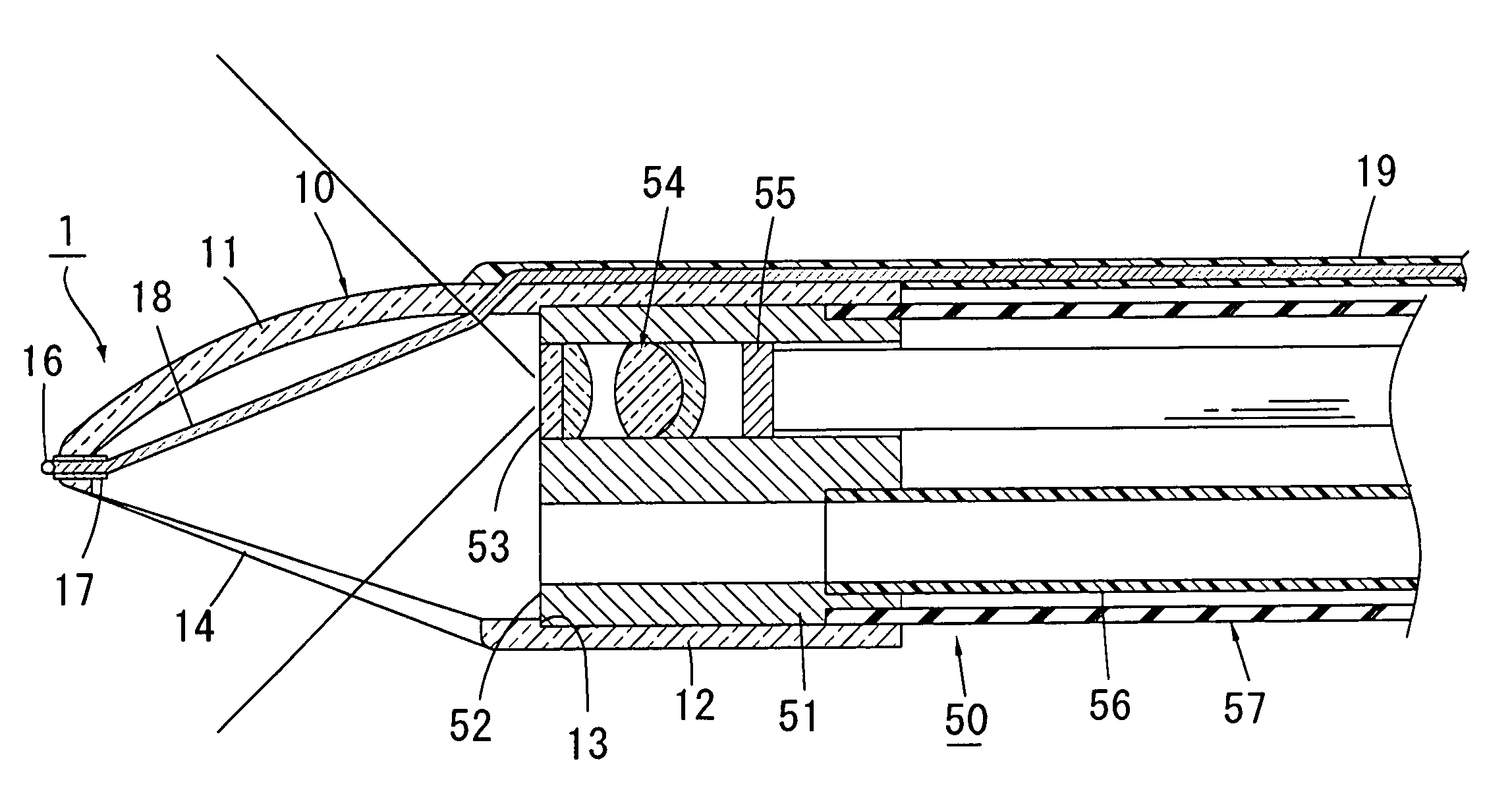Endoscopic high-frequency knife
a high-frequency knife and endoscope technology, applied in the field of endoscopic high-frequency knives, can solve the problems of difficult to determine the cutting depth, the inability to view in real time the dissected surface of the submucosa in the process of being dissected by the high-frequency cutting electrode, and the excessive dissection of body tissue by the unintentional depth. , to achieve the effect of easy and safe dissection of the medically optimal prescribed area of the submu
- Summary
- Abstract
- Description
- Claims
- Application Information
AI Technical Summary
Benefits of technology
Problems solved by technology
Method used
Image
Examples
first embodiment
[First Embodiment]
[0080]In the first embodiment, as shown in the cross sectional view in FIG. 1, an endoscopic high-frequency knife 1 has a transparent hood (attachment) 10 which is mounted to a cylindrical distal end member 51 fixed at a distal end of an endoscope 50 to surround an end surface 52 of the cylindrical distal end member 51, an objective window 53 being positioned on the end surface 52 of the cylindrical distal end member 51; a transparent hood portion 11 which is formed on the transparent hood 10 to project forward. from a portion of the transparent hood 10 in the vicinity of the end surface 52 while being gradually curved inwards so as to cover the front of the end surface 52 in a direction away from the end surface; and a high-frequency cutting electrode (conductive wire) 16 attached to the transparent hood 10 in the vicinity of a tip of the transparent hood portion 11 to project forward therefrom.
[0081]FIG. 1 shows a state where the endoscopic high-frequency knife 1...
second embodiment
[Second Embodiment]
[0101]FIG. 10 is a cross sectional view of a second embodiment of the endoscopic high-frequency knife 2 according to the present invention, while FIG. 11 is a bottom view thereof. In this embodiment, a high-frequency cutting electrode 216 is formed in an arc shape which bulges forward. In this manner, the shape of the high-frequency cutting electrode 216 is optional.
third embodiment
[Third Embodiment]
[0102]FIG. 12 is a cross sectional view of a third embodiment of the endoscopic high-frequency knife 3 according to the present invention, FIG. 13 is a front view thereof viewed in the direction of an arrow XIII shown in FIG. 12, and FIG. 14 is a bottom view, partly cross section, of the endoscopic high-frequency knife 3, viewed in the direction of an arrow XIV shown in FIG. 12. As shown in FIG. 14, the high-frequency cutting electrode 316 is formed in the shape of an arc which extends along the curved tip of a hood portion 311 of the transparent hood 310.
[0103]In the third embodiment of the endoscopic high-frequency knife 3, the hood portion 311 of the transparent hood 310 is shaped to fully cover the front of the distal end member 51 of the endoscope 50, the rear end of the opening 314 which is positioned in front of the end surface 52 being larger in a circumferential direction of the transparent hood 310, the two conductive wires 18 are drawn out directly from ...
PUM
 Login to View More
Login to View More Abstract
Description
Claims
Application Information
 Login to View More
Login to View More - R&D
- Intellectual Property
- Life Sciences
- Materials
- Tech Scout
- Unparalleled Data Quality
- Higher Quality Content
- 60% Fewer Hallucinations
Browse by: Latest US Patents, China's latest patents, Technical Efficacy Thesaurus, Application Domain, Technology Topic, Popular Technical Reports.
© 2025 PatSnap. All rights reserved.Legal|Privacy policy|Modern Slavery Act Transparency Statement|Sitemap|About US| Contact US: help@patsnap.com



